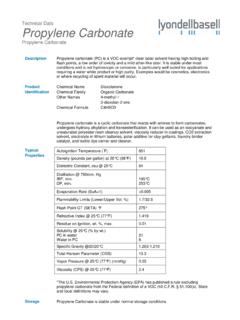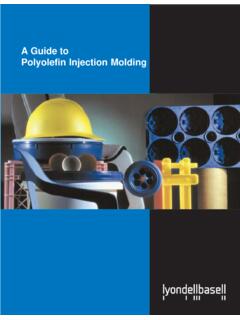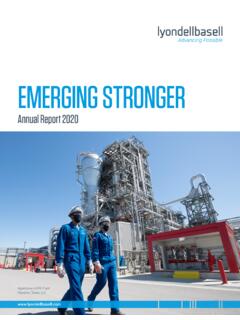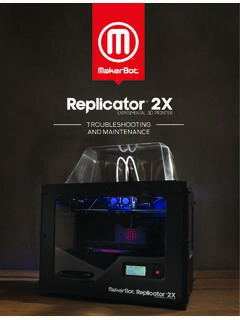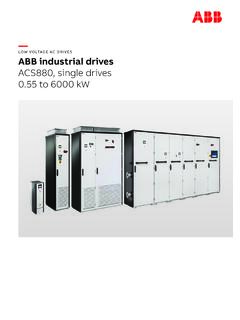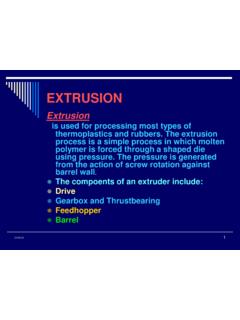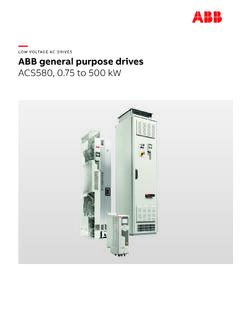Transcription of How to Solve Blow Molding Problems - LyondellBasell
1 How to Solve blow Molding Problems How to Solve blow Molding Problems This booklet reviews some Problems that may occur during blow Molding operations. Although millions of objects are blow molded each year, blow Molding is not a simple processing technique. Possible defects are many and various. This booklet primarily deals with these Problems as they appear in lightweight, thin-walled parts, such as bottles and containers. However, many of the recommended solutions also apply to heavier, thicker objects. Table of Contents Page Rocker Bottoms and Oval Necks .. 2. Defects Within the Blown Wall .. 2. Poor Weld or Pinch-off and Indented Parting Lines .. 3. Poor Bottle Surface .. 5. Curtaining and Webbing .. 6. blow -outs .. 7. Parison Curl, Stringing, Hooking, Sag and Length Inconsistency .. 7. Foreign Matter in the Melt .. 9. Die Lines or Streaking in the Parison .. 10. Shrinkage .. 10.
2 1. 4. Cycles too short n If 1, 2 and 3 have not solved the problem , Rocker Bottoms and Oval Necks determine whether the cycle times are unrealistically short to keep productivity These two defects in blow molded objects are high. If cycles are reasonable for adequate the result of warpage. The cause is, in general, cooling, proceed to the next group of the same that results in warping in parts made possibilities. from other plastics Molding processes: inadequate or uneven cooling of the part prior 5. Poorly designed cooling channels to its removal from the mold. Possible causes n The mold may have to be reworked to and solutions follow: increase cooling capability or the uniformity of cooling. 6. Poorly designed part n Too great a variation in the distribution of material in the part, yielding unnecessarily thick and thin sections, result in warpage unless the part is thoroughly cooled.
3 This may demand an uneconomically long cycle. Parison programming or a redesign of the part itself may be necessary. Defects Within the Blown Wall Bubbles in the wall and cold spots both spoil the appearance of the blow molded object. While these two defects are unrelated, they may have similar causes. Bubbles are generally symmetrical areas on the wall of the object, usually clearer than the Rocker Bottoms surrounding area. Moisture in the melt is the usual cause. Following are some methods for eliminating this problem . 1. Insufficient cooling water to the mold n Increase flow and determine if this eliminates warpage. 2. Stock temperature too high n Try dropping the temperature by small amounts to see if this will Solve the prob- lem without resulting in new concerns such as cold spots in the container wall. 3. Blocked cooling channels n Check the cool out throughput. If it is significantly less than when the mold was new, a thorough cleaning of the channels is needed.
4 Bubbles 2. 1. Moisture condenses on the surface of cold Cold Spots also can result from a resin mixture in resin that is exposed to the warmth of the blow which some material has a lower melt index. The Molding shop. resin does not melt completely and extrusion n Allow the resin to warm up and the conditions are inadequate for the lower melt index moisture to evaporate before it enters the material, resulting in defects on the blow molded extruder. part. n Let the resin warm up by keeping a few unopened gaylords in a warm room. n Discharge direct draws from hopper cars or Poor Weld or Pinch-off and trucks into indoor surge bins where the resin can warm up and moisture evaporate before Indented Parting Lines moving to the extruder hopper. There are three distinct weld or pinch-off n Increase barrel temperature in the feed defects: and/or transition sections of the screw to n Thinning of the weld remove any further moisture.
5 N Tearing of the flash during trimming 2. Overdone water cooling on the throat of the n Cutting at the pinch-off extruder, resulting in water condensing in the barrel Causes include the resin used, Molding conditions, mold design or a combination of n Decrease water cooling on the throat. these factors. 3. Non-moisture causes of bubbles n Check material leaking from mismatched Thinning head sections and rectify, as this also can be a source of degraded resin. 1. Stock temperature too high n Make sure back pressure is sufficient. If n As the molds close and the pinch-off is not, adjust the back pressure gauge on made, the pinch-off lands fail to force reciprocating blow Molding machines and enough material into the weld line to make change to a finer mesh screen pack on a strong weld. First, gradually drop the continuous extruders . stock temperature to see if this solves the problem .
6 If it does not, continue below. n Check for screw wear. If severe, replace the screw. 2. Too short or too sharp a pinch-off land length n Adjust the pinch-off land length. Cold Spots show up as non-homogeneous areas n Refinish pinch-off lands. in the wall of the blown object. This can also be caused by insufficient back pressure or non- 3. Excessive pre- blow or high pressure air uniformity in the melt. Solutions are the same as coming on too early for bubbles. n Gradually back off the pre- blow air to a point that does not affect the other areas of the container. n If the above does not Solve the problem , increase the blow delay time. Care must be taken when doing this to avoid affecting other areas of the container. Cold Spots 3. 3. Molds mismatched n Caused by worn locating pins which must be replaced. 4. Molds damaged n Nicks and other damage in the pinch-off areas indicate a need to fill and regrind the molds.
7 5. Mold clamp pressure uneven n Molds that appear to have torn pinch-offs Thinning of the Weld in one area and not another are probably not closing and clamping evenly. Adjust the clamp. If the clamp cannot be adjusted, Tearing the molds can be shimmed out at the 1. Pinch-off land length too long problem area. n Long pinch-off land length forces more material into the weld line, resulting in a strong weld. If overdone, however, a long pinch-off land length can prevent the molds from closing completely, leaving a thick pinch-off line that is apt to tear during trimming. The weld is then ragged, rough and possibly torn open. n Have the molds reworked to reduce the land length to to inch, the Cutting at the Pinch-Off common range in polyethylene blow Molding . This land length results in a good balance between a strong weld and a Cutting can be the problem if a hole or slit is trimmable pinch-off.
8 Found in a weld in a part with flash attached. 1. Stock temperature too low n If the weld and pinch-off both seem satisfactory but there is a hole or slit along the weld, the parison may be tearing as the mold closes because of cold stock. Raise the stock temperature in 5-10 F. increments until the cutting ceases. 2. Molds close too fast and slam or snap shut . Ease off the closing cycle to make better welds and preserve the molds. Indented Parting Lines appear as a V shape Tearing of the Flash where they pull into the blown object. 1. Insufficient blow pressure or air entrapment 2. Pinch-offs worn due to poor venting n Correct temporarily by rolling them n Raise the blow pressure. back; refurbishing is necessary. n Clean the mold vents. n If the above do not work, sandblast the molds to improve venting. 4. 6. Condensed water in the mold n Gradually raise the mold temperature, if Poor Bottle Surface possible.
9 N If raising the mold temperature cannot be Roughness, pits and orange peel are only done without increasing cycle time, it may be a few of the terms used to describe the less necessary to air condition some localized than perfect surfaces that can be found on areas of the plant during periods of high blown bottles. One cause is an imperfect humidity. High humidity combined with low parison. Other causes are related to the mold temperatures can result in water mold and the blow Molding process. condensing in the mold between the ejection of a part and the blow Molding of the next. 1. Poor mold surface n Refinish a poor or worn mold surface. The mold should have a fine matte finish to allow air to vent quickly and the parison to conform to the mold surface while it is still hot. 2. Plugged or inadequate vents n Clean plugged or dirty vents, particularly those along the parting line. n Rework the mold to enlarge vents that are too small or increase the number of vents Condensed Water in Mold to enable air to escape rapidly.
10 When air cannot escape, surface Problems result. 3. Low blow pressure or blow rate 7. Rough parison n Increase the blow pressure. n A rough parison usually results from n Determine whether the blow pin is large operating the blow Molding process at a enough to handle the required amount of shear rate that produces flow instability in air to fully and rapidly blow mold the part. the melt. Melt instability is more likely to occur when continuous extruders are run n Check for restrictions or partial plugging of near or at the highest rates of which they the air lines. are capable. With reciprocating or 4. Air leak around the blow pin accumulator types of blow Molding n Repair the leak. Air leakage around the machines, melt instability is more likely to blow pin means that there is not sufficient occur when the extruders are run near or air pressure to hold the part tightly against at the slowest rates of which they are the mold.
